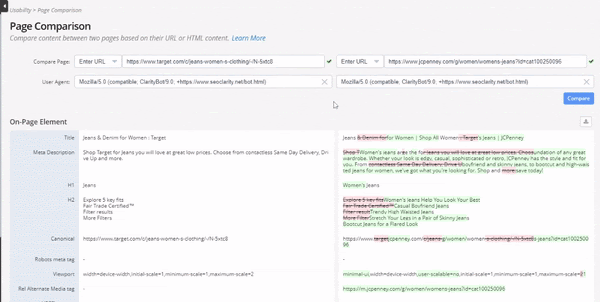Comparing web pages side-by-side offers incredible value. You can confirm site changes, find missed opportunities, and even monitor the competition.
seoClarity’s Page Comparison feature allows you to do just that with a few simple clicks. You’re able to compare the content of two pages by either the URL or HTML.
In this blog, I’ll walk you through how this works, why it’s important, and next steps to take.
Key Takeaways
- Side-by-side page comparisons make it easier to spot missed optimizations and competitive gaps quickly.
- Comparing devices, environments, and templates helps catch SEO issues before they become production problems.
- Use page comparisons to validate specific changes, then rely on full crawls to scale insights.
Table of Contents
- Why Compare Two Website Page
- How to Use Page Comparison for Instant Analysis
- Next Steps After Running a Page Comparison
Why Compare Two Website Pages
There are a few reasons to compare one web page with another. One of my favorite use cases is checking in on the competition, so let’s start there.
Compare Your Website Content to Competitor Pages
The page comparison doesn’t have to be of pages on the same site — it can be pages from two websites.
Get a clear view of competitor on-page elements to identify gaps, overlaps, and optimization opportunities
A good tactic here is to compare your category page to theirs. This reveals how they approach the page title, H1 headings, canonicals, content length, and plenty more.
Comparing Mobile and Desktop Page Content
You may have mobile pages that differ from your desktop pages since they each offer unique experiences.
In order to compare the on-page content of desktop and mobile, you can use Page Comparison and change the user agent to run the analysis (since the pages likely have the same URL). That is, you specify the user agent used when crawling the content. One should be set to mobile, the other desktop.
Or, if you run a mobile m. site, the URL will naturally be different than the desktop version of the site (i.e. www).
Comparing QA and Live Page Environments
Before you push site changes live, you can run the HTML of the test environment through the Page Comparison feature to compare the changes to the already-live content. All changes should be reviewed and confirmed before they go live!
Comparing SEO Signals Across Page Templates
The last use case I want to cover is comparing page templates. Take product category and product pages, for example.
You should compare your product page to your category page to confirm that there’s an equal amount of SEO optimizations on each page template. The pages shouldn’t share too high of a content similarity.
Essentially, you want to highlight the differences and make sure each has unique on-page elements and is properly optimized.
How to Use Page Comparison for Instant Analysis
Page Comparison lives within the usability portion of the seoClarity platform.
Once you enter the two URLs or two HTMLs (or one of each) you select the user agent. Again, for an example like mobile vs. desktop you would change the user agent to see the changes because the URL is the same on desktop and mobile.

(A competitor analysis in Page Comparison.)
Here’s what the full comparison looks like:

(The Page Comparison feature generates a color-specified report.)
You’ll notice that the content in the left column is untouched. Think of this as your base content.
Then, the content on the right column is marked up with red or green. These colors highlight the changes. Red strike-throughs indicate content not present, green highlights indicate additional content that is present.
Recommended Reading: Monitor Site Changes (and Protect Your SEO) with a Change Monitoring System
If an element was not found at the time of crawling, then a dash is displayed.
Some of the information included in the comparison includes:
On-page elements Included in Page Comparison
- Page Title
- Meta description
- H1
- H2
- Canonical
- Content Length
- Hreflang
- Download Time
On-Page Issue Analysis Using Page Comparison
- Meta description tag empty
- Hyperlinks use relative reference
- Hreflang not present
- Heading tag empty
- More than 100 hyperlinks found
All of the on-page elements help search engines and users alike understand your site, so take the time to make all proper optimizations.
Next Steps After Running a Page Comparison
After you run the page comparison, you’ll know of the issues that you discovered in the analysis. This could be working with your Dev team to make necessary site changes, or fixing content issues that you noticed after running a competitive analysis.
Remember that this is only a two-page comparison. To really go in-depth with your pages’ elements, run a full crawl. The page comparison is a sneak peek, while the built-in crawler provides a deeper, more scalable view of site-wide patterns.
Editor's Note: This post has been updated for recency and accuracy due to the nature of our rapidly evolving industry.







1 Comment
Click here to read/write comments